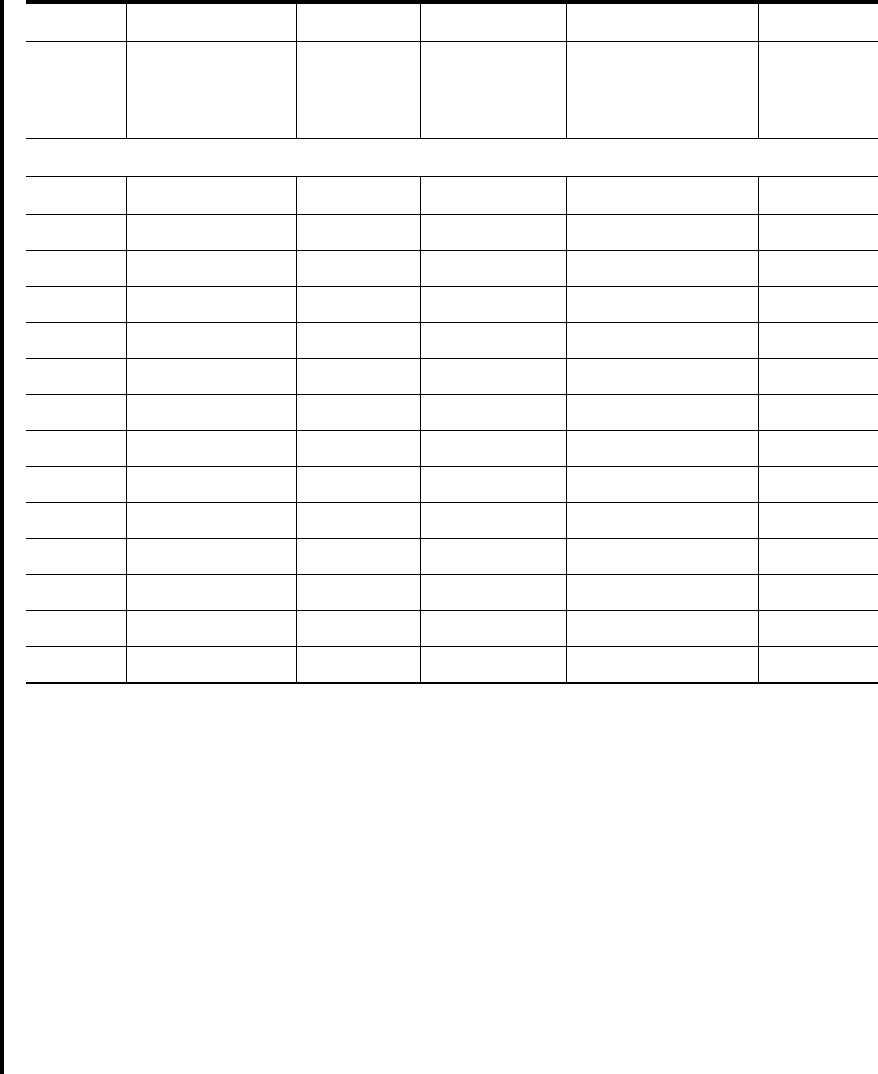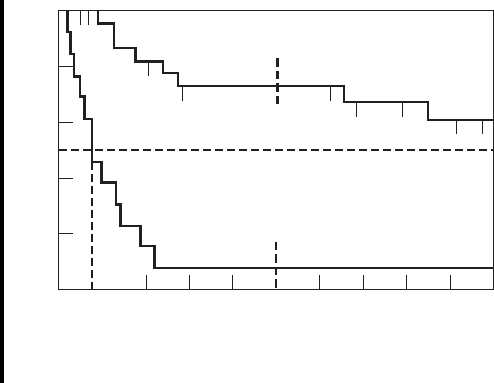Daniel W.W. Biostatistics: A Foundation for Analysis in the Health Sciences
Подождите немного. Документ загружается.


12.7.2 The objective of a prospective study by Stenestrand et al. (A-20) was to compare the mortality rate
following an acute myocardial infarction (AMI) among subjects receiving early revascularization to
the mortality rate among subjects receiving conservative treatments. Among 2554 patients receiving
revascularization within 14 days of AMI, 84 died in the year following the AMI. In the conservative
treatment group (risk factor present), 1751 of 19,358 patients died within a year of AMI. Compute
the relative risk of mortality in the conservative treatment group as compared to the revascularization
group in patients experiencing AMI.
12.7.3 Refer to Example 12.7.2. Toschke et al. (A-17), who collected data on obesity status of children
ages 5–6 years and the smoking status of the mother during the pregnancy, also reported on
another outcome variable: whether the child was born premature (37 weeks or fewer of gesta-
tion). The following table summarizes the results of this aspect of the study. The same risk fac-
tor (smoking during pregnancy) is considered, but a case is now defined as a mother who gave
birth prematurely.
Premature Birth Status
Smoking Status
During Pregnancy Cases Noncases Total
Smoked throughout 36 370 406
Never smoked 168 3396 3564
Total 204 3766 3970
Source: A. M. Toschke, S. M. Montgomery, U. Pfeiffer, and
R. von Kries, “Early Intrauterine Exposure to Tobacco-Inhaled
Products and Obesity,” American Journal of Epidemiology,
158 (2003), 1068–1074.
Compute the odds ratio to determine if smoking throughout pregnancy is related to premature birth.
Use the chi-square test of independence to determine if one may conclude that there is an associ-
ation between smoking throughout pregnancy and premature birth. Let
12.7.4 Sugiyama et al. (A-21) examined risk factors for allergic diseases among 13- and 14-year-old
schoolchildren in Japan. One risk factor of interest was a family history of eating an unbalanced
diet. The following table shows the cases and noncases of children exhibiting symptoms of rhini-
tis in the presence and absence of the risk factor.
Rhinitis
Family History Cases Noncases Total
Unbalanced diet 656 1451 2107
Balanced diet 677 1662 2339
Total 1333 3113 4446
Source: Takako Sugiyama, Kumiya Sugiyama, Masao Toda,
Tastuo Yukawa, Sohei Makino, and Takeshi Fukuda, “Risk Factors
for Asthma and Allergic Diseases Among 13–14-Year-Old
Schoolchildren in Japan,” Allergology International, 51 (2002),
139–150.
a = .05.
EXERCISES 647

What is the estimated odds ratio of having rhinitis among subjects with a family history of an
unbalanced diet compared to those eating a balanced diet? Compute the 95 percent confidence
interval for the odds ratio.
12.7.5 According to Holben et al. (A-22), “Food insecurity implies a limited access to or availability of
food or a limited/uncertain ability to acquire food in socially acceptable ways.” These researchers
collected data on 297 families with a child in the Head Start nursery program in a rural area of
Ohio near Appalachia. The main outcome variable of the study was household status relative to
food security. Households that were not food secure are considered to be cases. The risk factor of
interest was the absence of a garden from which a household was able to supplement its food sup-
ply. In the following table, the data are stratified by the head of household’s employment status
outside the home.
Stratum 1 (Employed Outside the Home)
Risk Factor Cases Noncases Total
No garden 40 37 77
Garden 13 38 51
Total 53 75 128
Stratum 2 (Not Employed Outside the Home)
Risk Factor Cases Noncases Total
No garden 75 38 113
Garden 15 33 48
Total 90 71 161
Source: David H. Holben, Ph.D. and John P. Holcomb, Jr., Ph.D. Used with permission.
Compute the Mantel–Haenszel common odds ratio with stratification by employment status. Use
the Mantel–Haenszel chi-square test statistic to determine if we can conclude that there is an asso-
ciation between the risk factor and food insecurity. Let
12.8 SURVIVAL ANALYSIS
In many clinical studies, an investigator may wish to monitor the progress of patients
from some point in time, such as the time a surgical procedure is performed or a treat-
ment regimen is initiated, until the occurrence of some well-defined event such as death
or cessation of symptoms.
Suppose, for example, that patients who have experienced their first heart attack
are enrolled in a study to assess the effectiveness of two competing medications for the
prevention of a second myocardial infarction. The investigation begins when the first
patient, following his or her first heart attack, is enrolled in the study. The study con-
tinues until each patient in the study experiences one or another of three events: (1) a
myocardial infarction (the event of interest), (2) loss to follow-up for some reason such
as death from a cause other than a heart attack or having moved to another locality, or
a = .05.
648 CHAPTER 12 THE CHI-SQUARE DISTRIBUTION AND THE ANALYSIS OF FREQUENCIES

(3) the condition of being alive at the time the investigator decides to terminate the
study.
For each patient in the study, the investigator records the amount of time (in
months, days, years, or some other measures of time) elapsing between the point at which
the patient entered the study and the point at which he or she experienced one of the
terminating events. The time elapsing between enrollment in the study and the experi-
encing of one of the events is referred to as the patient’s survival time. The set of such
survival times recorded during the course of a study is referred to as survival data.
Suppose we have the following information on three of the patients in the study
involving heart-attack patients. Patient A entered the study on January 1, 2002, and had
a myocardial infarction on December 31, 2003. Patient A’s survival time is 24 months.
Patient B entered the study on July 1, 2002, and moved out of state on December 31,
2002. Patient B’s survival time is 6 months. Patient C entered the study on August 1,
2002, and was still alive when the study was terminated on December 31, 2004. Patient
C’s survival time is 29 months. The survival time for patient B is called a censored sur-
vival time, since the terminating event was loss to follow-up rather than the event of
interest. Similarly, since the terminating event for patient C was being alive at the end
of the study, this patient’s survival time is also called a censored survival time. The sur-
vival times for patient B and patient C are called censored data. The experiences of these
three patients may be represented graphically as shown in Figure 12.8.1.
Censored data can arise in a variety of ways. In singly censored data, a fixed num-
ber of subjects enter into a study at the same time and remain in the study until one of
two things occur. First, at the conclusion of the study, not all of the subjects may have
experienced a given condition or endpoint of interest, and therefore their survival times are
not known exactly. This is called type I censoring. Second, the study may be ended after
a certain proportion of subjects have experienced a given condition. Those that did not
experience the condition would not have a known survival time. This is called type II cen-
soring. A third type of censoring leads to progressively censored data. In this type of cen-
soring, the period of the study is fixed, but subjects may enter the experiment at different
times. (For example, in a clinical study, patients can enter the study at any time after diag-
nosis.) Patients may then experience, or not experience, a condition by the end of the study.
Those who did not experience the condition do not have known survival times. This is
called type III censoring. Clearly the details surrounding censored data are complex and
12.8 SURVIVAL ANALYSIS 649
Jan.1
2002
July 1
2002
Jan. 1
2003
Jan. 1
2004
Dec. 31
2004
A
B
C
Patient
FIGURE 12.8.1 Patients entering a study at different times with
known ( ) and censored ( ) survival times.
䊊䊉
require much more detailed analysis than can be covered in this text. For those interested
in further reading, we suggest the books by Lee (28) or Hosmer and Lemeshow (34).
Typically, for purposes of analysis, a dichotomous, or indicator, variable is used to
distinguish survival times of those patients who experienced the event of interest from
the censored times of those who did not experience the event of interest because of loss
to follow-up or being alive at the termination of the study.
In studies involving the comparison of two treatments, we are interested in three items
of information for each patient: (1) Which treatment, A or B, was given to the patient?
(2) For what length of time was the patient observed? (3) Did the patient experience the event
of interest during the study or was he or she either lost to follow-up or alive at the end of
the study? (That is, is the observed time an event time or a censored time?) In studies that
are not concerned with the comparison of treatments or other characteristics of patients, only
the last two items of data are relevant.
Armed with these three items of information, we are able, in studies like our
myocardial infarction example, to estimate the median survival time of the group of
patients who received treatment A and compare it with the estimated median survival time
of the group receiving treatment B. Comparison of the two medians allows us to answer
the following question: Based on the information from our study, which treatment do we
conclude delays for a longer period of time, on the average, the occurrence of the event
of interest? In the case of our example, we may answer the question: Which treatment do
we conclude delays for a longer period of time, on the average, the occurrence of a sec-
ond myocardial infarction? The data collected in follow-up studies such as we have
described may also be used to answer another question of considerable interest to the cli-
nician: What is the estimated probability that a patient will survive for a specified length
of time? The clinician involved in our myocardial infarction study, for example, might
ask, “What is the estimated probability that, following a first heart attack, a patient receiv-
ing treatment A will survive for more than three years?” The methods employed to answer
these questions by using the information collected during a follow-up study are known as
survival analysis methods.
The Kaplan–Meier Procedure Now let us show how we may use the data
usually collected in follow-up studies of the type we have been discussing to estimate
the probability of surviving for a specified length of time. The method we use was intro-
duced by Kaplan and Meier (24) and for that reason is called the Kaplan–Meier proce-
dure. Since the procedure involves the successive multiplication of individual estimated
probabilities, it is sometimes referred to as the product-limit method of estimating sur-
vival probabilities.
As we shall see, the calculations include the computations of proportions of sub-
jects in a sample who survive for various lengths of time. We use these sample propor-
tions as estimates of the probabilities of survival that we would expect to observe in the
population represented by our sample. In mathematical terms we refer to the process as
the estimation of a survivorship function. Frequency distributions and probability distri-
butions may be constructed from observed survival times, and these observed distribu-
tions may show evidence of following some theoretical distribution of known functional
form. When the form of the sampled distribution is unknown, it is recommended that
the estimation of a survivorship function be accomplished by means of a nonparametric
650
CHAPTER 12 THE CHI-SQUARE DISTRIBUTION AND THE ANALYSIS OF FREQUENCIES

technique, of which the Kaplan–Meier procedure is one. Nonparametric techniques are
defined and discussed in detail in Chapter 13.
Calculations for the Kaplan–Meier Procedure We let
the number of subjects whose survival times are available
the proportion of subjects surviving at least the first time period
(day, month, year, etc.)
the proportion of subjects surviving the second time period
after having survived the first time period
the proportion of subjects surviving the third time period
after having survived the second time period
the proportion of subjects surviving the kth time period
after having survived the th time period
We use these proportions, which we may relabel as estimates of
the probability that a subject from the population represented by the sample will survive
time periods k, respectively.
For any time period, we estimate the probability of surviving the
tth time period, as follows:
(12.8.1)
The probability of surviving to time is estimated by
(12.8.2)
We illustrate the use of the Kaplan–Meier procedure with the following example.
EXAMPLE 12.8.1
To assess results and identify predictors of survival, Martini et al. (A-23) reviewed
their total experience with primary malignant tumors of the sternum. They classified
patients as having either low-grade (25 patients) or high-grade (14 patients) tumors.
The event (status), time to event (months), and tumor grade for each patient are shown
in Table 12.8.1. We wish to compare the 5-year survival experience of these two groups
by means of the Kaplan–Meier procedure.
Solution: The data arrangement and necessary calculations are shown in Table 12.8.2.
The entries for the table are obtained as follows.
1. We begin by listing the observed times in order from smallest to largest
in Column 1.
S
N
1t2= p
N
1
* p
N
2
*
. . .
* p
N
t
t, S1t2,
p
N
t
=
number of subjects surviving at least 1t - 12 time periods
who also survive the tth period
number of subjects alive at end of time period 1t - 12
p
t
,
t11 … t … k2,
1, 2, 3, . . . ,
p
N
1
, p
N
2
, p
N
3
, . . . , p
N
k
1k - 12
p
k
=
.
.
.
p
3
=
p
2
=
p
1
=
n =
12.8 SURVIVAL ANALYSIS 651

2. Column 2 contains an indicator variable that shows vital status
3. In Column 3 we list the number of patients at risk for each time asso-
ciated with the death of a patient. We need only be concerned about the
times at which deaths occur because the survival rate does not change
at censored times.
4. Column 4 contains the number of patients remaining alive just after one
or more deaths.
5. Column 5 contains the estimated conditional probability of surviving,
which is obtained by dividing Column 4 by Column 3. Note that,
although there were two deaths at 15 months in the low-grade group and
two deaths at 9 months in the high-grade group, we calculate only one
survival proportion at these points. The calculations take the two deaths
into account.
6. Column 6 contains the estimated cumulative probability of survival. We
obtain the entries in this column by successive multiplication. Each entry
11 = died, 0 = alive or censored2.
652
CHAPTER 12 THE CHI-SQUARE DISTRIBUTION AND THE ANALYSIS OF FREQUENCIES
TABLE 12.8.1 Survival Data, Subjects with Malignant Tumors of the Sternum
Time Vital Tumor Time Vital Tumor
Subject (Months) Status
a
Grade
b
Subject (Months) Status
a
Grade
b
1 29 dod L 21 155 ned L
2 129 ned L 22 102 dod L
3 79 dod L 23 34 ned L
4 138 ned L 24 109 ned L
5 21 dod L 25 15 dod L
6 95 ned L 26 122 ned H
7 137 ned L 27 27 dod H
8 6 ned L 28 6 dod H
9 212 dod L 29 7 dod H
10 11 dod L 30 2 dod H
11 15 dod L 31 9 dod H
12 337 ned L 32 17 dod H
13 82 ned L 33 16 dod H
14 33 dod L 34 23 dod H
15 75 ned L 35 9 dod H
16 109 ned L 36 12 dod H
17 26 ned L 37 4 dod H
18 117 ned L 38 0 dpo H
19 8 ned L 39 3 dod H
20 127 ned L
a
dod dead of disease; ned no evidence of disease; dpo dead postoperation.
b
L low-grade; H high-grade.
Source: Dr. Nael Martini. Used with permission.
==
===

12.8 SURVIVAL ANALYSIS 653
TABLE 12.8.2 Data Arrangement and Calculations for Kaplan–Meier Procedure,
Example 12.8.1
123456
Vital Status Patients Cumulative
Time Censored Patients Remaining Survival Survival
(Months) Dead at Risk Alive Proportion Proportion
Patients with Low-Grade Tumors
60
80
11 1 23 22 .956522
15 1
15 1 22 20 .869564
21 1 20 19 .826086
26 0
29 1 18 17 .780192
33 1 17 16 .734298
34 0
75 0
79 1 14 13 .681847
82 0
95 0
102 1 11 10 .619860
109 0
109 0
11 7 0
127 0
129 0
137 0
138 0
155 0
212 1 2 1 .309930
337 0
1>2 = .500000
10>11 = .909090
13>14 = .928571
16>17 = .941176
17>18 = .944444
19>20 = .950000
20>22 = .909090
22>23 = .956522
1
0
(
Continued
)

after the first in Column 5 is multiplied by the cumulative product of all
previous entries.
After the calculations are completed we examine Table 12.8.2 to deter-
mine what useful information it provides. From the table we note the fol-
lowing facts, which allow us to compare the survival experience of the two
groups of subjects: those with low-grade tumors and those with high-grade
tumors:
1. Median survival time. We can determine the median survival time by
locating the time, in months, at which the cumulative survival propor-
tion is equal to .5. None of the cumulative survival proportions are ex-
actly .5, but we see that in the low-grade tumor group, the probability
changes from .619860 to .309930 at 212 months; therefore, the median
survival for this group is 212 months. In the high-grade tumor group, the
654
CHAPTER 12 THE CHI-SQUARE DISTRIBUTION AND THE ANALYSIS OF FREQUENCIES
123456
Vital
Status Patients Cumulative
Time Censored Patients Remaining Survival Survival
(Months) Dead at Risk Alive Proportion Proportion
Patients with High-Grade Tumors
0 1 14 13 .928571
2 1 13 12 .857142
3 1 12 11 .785714
4 1 11 10 .714285
6 1 10 9 .642856
7 1 9 8 .571428
91
9 1 8 6 .428572
12 1 6 5 .357143
16 1 5 4 .285714
17 1 4 3 .214286
23 1 3 2 .142857
27 1 2 1 .071428
122 0 1 0
1>2 = .500000
2>3 = .666667
3>4 = .750000
4>5 = .800000
5>6 = .833333
6>8 = .750000
8>9 = .888889
9>10 = .900000
10>11 = .909090
11>12 = .916667
12>13 = .923077
13>14 = .928571
1
0

cumulative proportion changes from .571428 to .428572 at 9 months,
which is the median survival for this group.
2. Five-year survival rate. We can determine the 5-year or 60-month sur-
vival rate for each group directly from the cumulative survival proportion
at 60 months. For the low-grade tumor group, the 5-year survival rate is
.734298 or 73 percent; for the high-grade tumor group, the 5-year sur-
vival rate is .071428 or 7 percent.
3. Mean survival time. We may compute for each group the mean of the
survival times, which we will call and for the low-grade and high-
grade groups, respectively. For the low-grade tumor group we compute
and for the high-grade tumor group we compute
Since so many of the times in the low-grade group
are censored, the true mean survival time for that group is, in reality,
higher (perhaps, considerably so) than 88.04. The true mean survival time
for the high-grade group is also likely higher than the computed 18.35,
but with just one censored time we do not expect as great a difference
between the calculated mean and the true mean. Thus, we see that we
have still another indication that the survival experience of the low-grade
tumor group is more favorable than the survival experience of the high-
grade tumor group.
4. Average hazard rate. From the raw data of each group we may also cal-
culate another descriptive statistic that can be used to compare the two
survival experiences. This statistic is called the average hazard rate. It is
a measure of nonsurvival potential rather than survival. A group with a
higher average hazard rate will have a lower probability of surviving than
a group with a lower average hazard rate. We compute the average haz-
ard rate, designated by dividing the number of subjects who do not sur-
vive by the sum of the observed survival times. For the low-grade tumor
group, we compute For the high-grade tumor
group we compute We see that the average haz-
ard rate for the high-grade group is higher than for the low-grade group,
indicating a smaller chance of surviving for the high-grade group.
The cumulative survival proportion column of Table 12.8.2 may be por-
trayed visually in a survival curve graph in which the cumulative survival pro-
portions are represented by the vertical axis and the time in months by the
horizontal axis. We note that the graph resembles stairsteps with “steps”
occurring at the times when deaths occurred. The graph also allows us to rep-
resent visually the median survival time and survival rates such as the 5-year
survival rate. The graph for the cumulative survival data of Table 12.8.2 is
shown in Figure 12.8.2.
These observations strongly suggest that the survival experience of
patients with low-grade tumors is far more favorable than that of patients
with high-grade tumors.
h
H
= 13>257 = .05084.
h
L
= 9>2201 = .004089.
h
T
H
= 257>14 = 18.35.
T
L
= 2201>25 = 88.04,
T
H
T
L
12.8 SURVIVAL ANALYSIS
655

The results of comparing the survival experiences of two groups will not always
be as dramatic as those of our example. For an objective comparison of the survival expe-
riences of two groups, it is desirable that we have an objective technique for determin-
ing whether they are statistically significantly different. We know also that the observed
results apply strictly to the samples on which the analyses are based. Of much greater
interest is a method for determining if we may conclude that there is a difference between
survival experiences in the populations from which the samples were drawn. In other
words, at this point, we desire a method for testing the null hypothesis that there is no
difference in survival experience between two populations against the alternative that
there is a difference. Such a test is provided by the log-rank test. The log-rank test is an
application of the Mantel–Haenszel procedure discussed in Section 12.7. The extension
of the procedure to survival data was proposed by Mantel (25). To calculate the log-rank
statistic we proceed as follows:
1. Order the survival times until death for both groups combined, omitting censored
times. Each time constitutes a stratum as defined in Section 12.7.
2. For each stratum or time, we construct a table in which the first row con-
tains the number of observed deaths, the second row contains the number of
patients alive, the first column contains data for one group, say, group A, and the
second column contains data for the other group, say, group B. Table 12.8.3 shows
the table for time
3. For each stratum compute the expected frequency for the upper left-hand cell of
its table by Equation 12.7.5.
4. For each stratum compute by Equation 12.7.6.
5. Finally, compute the Mantel–Haenszel statistic (now called the log-rank statistic)
by Equation 12.7.7.
We illustrate the calculation of the log-rank statistic with the following example.
y
i
t
i
.
2 * 2t
i
,
656 CHAPTER 12 THE CHI-SQUARE DISTRIBUTION AND THE ANALYSIS OF FREQUENCIES
1.0
.8
.6
.5
.4
.2
0.0
120 24364860
73%
72 84 96 108 120
Time (Months)
Low grade (N = 25)
7%
High grade (N = 14)
FIGURE 12.8.2 Kaplan–Meier survival curve, Example 12.8.1,
showing median survival times and 5-year (60-month) survival rates. ■
